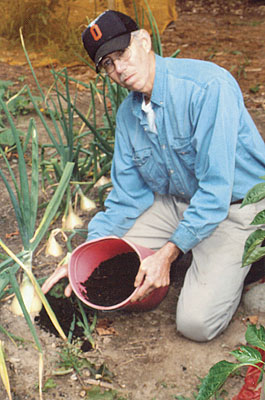 |
| John Fuchs with his ‘Ailsa Craig’ onions. Photo courtesy of John Fuchs. |
By John Fuchs
Three key factors are involved in bringing in a bumper crop of large, tasty onions in northern New England: providing the right soil conditions; planting onions at the right time; and selecting the right varieties to plant.
Onions grow best in a well draining soil that is loaded with organic matter. Onions really respond to a mixture of shredded leaves and well rotted cow or chicken manure. I prepare next year’s onion beds in the fall, when leaves are plentiful. I pile on the leaves – shredded by my lawnmower – 9 to 12 inches thick. Don’t skimp! I then spread several inches of well composted cow manure over the leaves and add 2 pounds of bone meal per 30-foot row.
Onions like a pH of 6.5 to 6.8, so if your soil is acidic, work some lime into it in the fall. I sprinkle wood ashes over the row instead of lime, as this not only raises the pH but also provides potassium. Wood ashes raise the pH faster than lime, so go easy on the application.
I turn the rows over thoroughly in the fall, and come spring, the soil is rich, deep and ready to plant.
If you prepare your onion bed this way, you won’t need to fertilize when you plant in the spring. You will, however, want to side dress your onions with blood meal and compost or a fish emulsion solution regularly throughout the spring. I side dress every two weeks from April through June. The size of the onion bulbs is related directly to the size of the onion leaves. Onion tops require a lot of nitrogen – hence the use of blood meal, compost and fish emulsion – and lots of water. I make sure they get 1 to 2 inches of water each week until July 4 – a must for getting big, juicy onions. Once the bulbs begin to form in late June or early July, stop side dressing and reduce watering.
For years I either bought onion sets and planted them in early May, or I planted onion seeds in the garden in April. I usually managed to get a fair crop, but I never got really large onions.
One year I decided to start my own onion seeds under grow lights on the first of March. On April 15, I transplanted these healthy green plants to the garden, and I harvested my biggest onions ever the first week of August.
So, the second ingredient in getting a big onion crop is to transplant your onions to the garden as early in April as possible – whether you grow them from seed yourself or purchase them. (I’ve done both.) I usually get them in the ground in my zone 5 garden between April 15 and 20. If you are in zone 3 or 4, you may need another week or two, but do get them in in April. Onions can handle a light frost or a blanket of snow. Once every five years or so, a hard frost will come in early May and you’ll have to protect your plants with blankets or some heavy row cover, but rarely will the plants be damaged.
Long-day onions – the kind growers in New England plant – need more than 15 hours of light daily during the peak of their growing cycle to form bulbs. The peak of their cycle is from early May to early July – hence the need to plant early.
Almost all long-day varieties will produce well if the soil is properly prepared, well watered, and the crop is planted early, but I have found that ‘Ailsa Craig,’ an English heirloom variety, consistently produces 1- to 2-pound onions with a sweetness that can’t be beat. They are also a surprisingly good keeper.
‘Copra,’ a yellow-skinned hybrid, is also very sweet.
‘Red Burgermaster’ is a mild, sweet, red onion that does well but does not keep as well as ‘Ailsa Craig’ and ‘Copra.’
Because onions are shallow rooted, light cultivation is important. Since onions are usually planted 3 or 4 inches apart, hand weeding is required early on. In late May I apply a thick hay or pine needle mulch to prevent weed growth and conserve moisture.
Insects or diseases rarely trouble onions. By rotating your beds, you can minimize trouble. A very wet year may present fungus problems, but if you select a well drained soil and use drip irrigation or soaker hoses, you should avoid fungus problems.
Onions are ready to harvest a couple of weeks after you notice their tops falling over – often in late July or early August. Dig the onions and spread them in the sun for several hours to dry. Next, cut off the tops, leaving a 1-inch neck, and spread the onions on a table or board away from the sun. After a week or two, brush off the soil.
Store the onions in mesh bags or trays in a cellar. Ideal temperatures are in the high 30s or in the 40s, but onions will last for months even at temperatures of around 50.
My ‘Ailsa Craig’ provided lots of good eating from Labor Day to St. Patrick’s Day.
About the author: John Fuchs gardens in Bellows Falls, Vermont.

